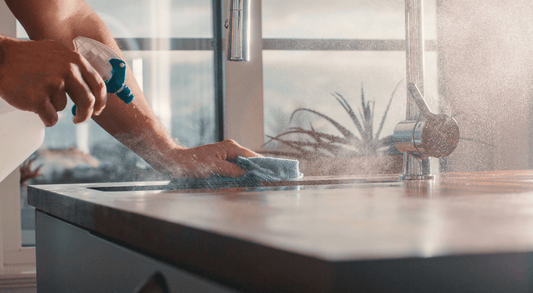Bath bombs are wonderful. There's nothing better than running a warm bath, adding a fizzy bath bomb, and relaxing. The scent and sensation is amazing.
Homemade bath bombs are an absolute treat. You can pick your colour and scent with mica powders and your favourite essential oils.
However, making bath bombs often takes a few attempts. We've put together a great recipe that you can try at home.
We tried 11 different bath bomb recipes until we came up with one that worked a treat, every time.
So, lets learn how to make bath bombs!
Contents:
This recipe makes 3 bath bombs
Prep time 30 mins and 24 hours setting
Equipment
- Bath bomb moulds
- Mixing bowl
- Measuring jug
- Weighing scales
- Gloves
Ingredients
- Bicarbonate of soda 225g
- Citric acid 115g
- Kaolin clay 70g
- Epsom salt 25g
- Arrowroot powder 10g
- Sweet almond oil 30g | 33ml
- Polysorbate 80 5g | 5ml
- Ylang ylang essential oil 6g | 6ml
- Fantasia pink mica powder 6g
Method

1. Weigh and mix your ingredients
- Accuracy is important in bath bomb making, so weigh carefully!
- Weigh your bicarbonate of soda, citric acid, kaolin clay, epsom salts, arrowroot powder and mica powder.
- Add them to your mixing bowl and mix until fully combined.
- Weigh your polysorbate 80, sweet almond oil and ylang ylang oil in a separate jug, and mix well until combined.

2. Combine the wet and dry ingredients
- Slowly add your liquid mixture to the dry mixture, stirring as you add. It is important to get the liquid absorbed by the dry ingredients as quickly as possible - otherwise it will start to fizz.
- Keep mixing until the moisture is spread evenly through the dry ingredients. If it is lumpy, you can push it through a sieve.

3. Test the recipe
- Your bath bomb mixture should clump together like wet sand.
- Test it by making a ball of mixture, then drop it into your bowl of mixture. It should just about hold together.
- We tested this DIY bath bomb recipe extensively, so there should be enough liquid in your mix.
- If you think your mix is too dry, first make sure that it is well mixed. Make sure there is no lumps and test it again.
- If it is still too dry, add 5ml sweet almond oil, then mix and repeat the test.

4. Fill your moulds
- Take spoonfuls of your mixture and press it into your moulds. Press firmly, but don’t pack it in too tightly, otherwise it won’t come out again!
- Fill each mould just proud of the top. This means that each half of the bath bomb will stick together.

5. Press and unmould your bath bombs
- Press the two halves of the bath bomb together firmly
- Remove the top half of the mould by gently squeezing the sides until it comes loose.
- If it doesn’t release from the mould, you may have packed it in too tightly. Dig it out of the mould and try again.
- Place the unmoulded side of the bath bomb in your hand
- Squeeze the sides of the remaining bath bomb mould until it comes loose.

6. Leave them to dry
- Place them somewhere dry, not the kitchen or bathroom. Humidity and water are the enemies of bath bombs.
- Leave them undisturbed for 24 hours so they can completely dry.
- Run a bath and enjoy!
FAQs
How to use a bath bomb?
Run yourself a bath, get in and drop your bath bomb in the water. Lie back and relax as the bath bomb fizzes and releases its glorious scent.
How does a bath bomb work?
The fizz of a bath bomb is caused by the reaction between bicarbonate of soda and citric acid. When the bath bomb is added to water, this starts the reaction off.
The arrowroot powder, kaolin clay, epsom salt and sweet almond oil all act to give your bath and skin a nice soft feel after using a bath bomb.
The essential oil is where your bath bomb gets its smell from. We’re using ylang ylang essential oil in this recipe, but you could switch it for another.
The polysorbate 80 acts to help the mica powder and essential oil blend into the bath water. This is important because it stops the essential oil from floating on top of the water and potentially irritating your skin. It also helps stop the mica powder from staining your bath.
How long does a bath bomb last?
Bath bombs will last for 6 - 12 months if stored correctly.
Storing bath bombs is all about keeping them away from water, including humid air. Store them in sealed containers, and if you have any silica gel sachets then add them to the container. These will really help your bath bombs stay dry.
How long does a bath bomb last in water?
We tested the fizz of our DIY bath bombs and measured it to be 4 minutes.
How to make a bath bomb without epsom salt?
You can adjust the recipe above by removing the epsom salt and adding an extra 25g of arrowroot powder.
How long does it take a bath bomb to dry?
Allow 24 - 48 hours for your DIY bath bombs to dry. Keep them out of the kitchen and bathroom, and away from moisture.
Why is my bath bomb sinking?
We've tested this recipe over and over again, and we've never managed to make these DIY bath bombs float. In time, we'll bring you a floating bath bomb recipe.
How to get a bath bomb out of a metal mould?
Bath bombs can be difficult to remove from metal moulds. The trick is not to pack the mixture in too tightly.
When you’re adding the mixture to your metal mould, press it in with the back of a spoon. Press firmly, but not hard. Keep adding mixture until it is filled just above the edge of the mould.
Next, press the two halves of the metal mould together. Then, take the top half of the mould and squeeze the sides a little until it comes free.
If the bath bomb splits in half, take the mixture out of the mould and try again. It took me at least 5 tries to get this right!
Once you’ve freed the top half from the mould, flip it over and repeat with the bottom half. You’re going to want to catch the bath bomb with your hand rather than turning the bath bomb out onto a hard surface. Your bath bomb is still very soft at this stage and will crumble easily, so it needs a soft landing! Again, it took me another 6 or 7 tries to get this right!
We’ve read quite a few guides that advise leaving your bath bombs to dry in the mould. However in my experience this frequently leads to the bath bombs getting stuck in the mould, and then the bath bombs won’t come out without breaking.
Again, I tried this at least 3 separate ways, and turning the bath bombs out immediately worked much better for me.
Is it cheaper to make or buy bath bombs?
If you compare the cost of our recipe to a mid-range £5 bath bomb, then it is certainly cheaper to make your own at home.
If you buy 500g-1kg of the powders, 250ml-500ml of the liquids and 100ml of the essential oil then you can make 3 bath bombs using this recipe for about £1.77 per bath bomb. Plus you get all the fun of trying to make bath bombs at home!
Why is my bath bomb mixture fizzing?
When you start to add the liquid ingredients to the solid ingredients, it is important to add them slowly whilst mixing. This stops patches of mixture becoming too wet and starting to react.
Fizzing can also be caused by working in an environment that is too humid, or adding too much liquid to your recipe.

Why is my bath bomb fizzing in the mould?
This is usually caused by one of two things: Either you’ve used too much liquid in your recipe, or your drying environment is too moist.
Make sure that your liquid measurements are 100% accurate and keep your bath bombs away from the kitchen or bathroom when you’re drying them.
I have also experienced this when I left bath bombs to dry on my radiator. However, the mixture was a little too wet as well.

Why are my bath bombs crumbling?
This can be caused by handling your bath bombs before they’ve fully dried. Don’t be tempted to test them before the 24-48 hours are up!
It can also be caused by not using enough liquid in your recipe.
Continue reading
Now that you've learned how to make bath bombs, why not continue your natural beauty journey?
- Learn how to make bath salts with our bath salt recipe
- Learn more about essential oils with our essential oils for soap making blog post
- Learn how to make body oil with our coconut body oil recipe
- Want to make your own bath truffle? Try our simple shea bath truffle recipe
How did your bath bombs turn out? Comment below and let us know.



